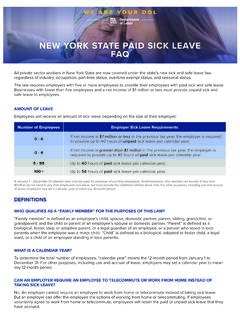Transcription of Why Do Women Earn Less Than Men? Evidence from Bus and ...
1 Why Do Women Earn Less Than Men? Evidence from Bus and Train Operators Valentin Bolotnyy Natalia Emanuel WORKING PAPERN ovember 28th, 2018 AbstractEven in a unionized environment where work tasks are similar, hourly wages are identi-cal, and tenure dictates promotions, female workers earn $ on the male-worker dollar(weekly earnings). We use confidential administrative data on bus and train operators fromthe Massachusetts Bay Transportation Authority (MBTA) to show that the weekly earningsgap can be explained by the workplace choices that Women and men make. Women valuetime away from work and flexibility more than men, taking more unpaid time off using theFamily Medical Leave Act (FMLA) and working fewer overtime hours than men. Whenovertime hours are scheduled three months in advance, men and Women work a similarnumber of hours; but when those hours are offered at the last minute, men work nearlytwice as many.
2 When selecting work schedules, Women try to avoid weekend, holiday, andsplit shifts more than men. To avoid unfavorable work times, Women prioritize their sched-ules over route safety and select routes with a higher probability of accidents. Women areless likely than men to game the scheduling system by trading off work hours at regularwages for overtime hours at premium wages. These results suggest that some policies thatincrease workplace flexibility, like shift swapping and expanded cover lists, can reduce thegender earnings gap and disproportionately increase the well-being of female workers. We want to thank Benjamin Enke, Edward Glaeser, Claudia Goldin, Nathaniel Hendren, Lawrence Katz, JeffLiebman, Amanda Pallais, Andrei Shleifer, Jane Waldfogel, and participants of the Public Finance and Labor Eco-nomics Workshop at Harvard for helpful comments and suggestions.
3 We are indebted to Joshua Abel, SiddharthGeorge, Emma Harrington, Dev Patel, and Jonathan Roth. This project would not have been possible without thesupport of dedicated public servants at the MBTA, including Michael Abramo, David Carney, Anna Gartsman,Philip Groth, Norman Michaud, Laurel Paget-Seekins, Steve Poftak, Vincent Reina, and Monica Tibbits-Nutt. IllanRodriguez-Marin Freudmann and Ezra Stoller were essential in helping administer a survey to help supplementour findings. We are grateful for financial support from the National Science Foundation, the Paul & Daisy SorosFellowship for New Americans, and the Rappaport Institute for Greater Boston at the Harvard Kennedy School. Department of Economics, Harvard University, Department of Economics, Harvard University, & EmanuelNovember 28, 20181 INTRODUCTIONThe ratio of female to male weekly earnings (for full-time workers) is currently , butwas in 1979 (Bureau of Labor Statistics, 2017).
4 1 Though female earnings have risen rela-tive to male earnings, why has the gender earnings gap persisted? We address this questionusing confidential administrative data on bus and train operators of the Massachusetts BayTransportation Authority (MBTA). Our setting allows us to control for many traditional expla-nations of the earnings gap, including occupational sorting, managerial bias, the motherhoodpenalty, and gender differences in desire to compete and negotiate for promotions. Despitehaving such a controlled setting, we document the existence of a gender earnings gap at theMBTA: female operators earn $ on the male-operator dollar in weekly earnings. Moreover,given the MBTA s defined benefit pension program, this earnings gap carries over into , the earnings gap can be explained in our setting by the fact that men take48% fewer unpaid hours off and work 83% more overtime hours per year than Women .
5 Thereason for these differences is not that men and Women face different choice sets in this , it is that Women have greater demand for workplace flexibility and lower demand forovertime work hours than men. These gender differences are consistent with Women takingon more of the household and childcare duties than men, limiting their work availability in theprocess (Parker et al., 2015; Bertrand et al., 2015).The MBTA s bus and train operators are all represented by the same union, Carmen s Lo-cal 589, and are all covered by the same bargaining agreement. The agreement specifies thatseniority in one s garage is the sole determinant of one s work opportunities. Conditional onseniority, men and Women face the same choice sets of schedules, routes, vacation days, andovertime hours, among other amenities.
6 The earnings gap persists even when we conditionon seniority, allowing us to explain the gap fully by the differences in choices that men andwomen make when faced with the same choice sets in the Bureau of Labor Statistics (BLS) calculates this ratio for each year by taking the average (for men andwomen separately) of median usual weekly earnings for full-time wage and salary & EmanuelNovember 28, 2018 When overtime hours are scheduled three months in advance, men sign up for about 7%more of them than Women . When overtime is scheduled the day before or the day of thenecessary shift, men work almost twice as many of those hours as Women . Given that theMBTA s operators are a select group of people who were not discouraged by the MBTA s jobpostings requiring 24/7 availability, these differences in values of time and flexibility are likelylower bounds for the general see Women prioritizing schedule convenience more than men in other respects.
7 Asoperators move up the seniority ladder and consequently have a greater pool of schedules topick from, Women move away from working weekends, holidays, and split shifts more thanmen. Women are more likely than men to take less desirable routes (defined as those routesalong which men experience more accidents) to avoid the less preferable our sample, which runs from 2011 through 2017, the Family Medical Leave Act(FMLA) plays a crucial role in giving operators the flexibility to take unpaid time off. Passedin 1993, FMLA is intended to allow workers facing a personal or family medical emergencyto take up to 12 weeks off from work without pay and without retribution from the use the law for maternity or paternity leave purposes. At the MBTA, the law has beennicknamed the Friday-Monday Leave Act for the way that operators have used it to avoidundesirable shifts.
8 We find that male operators exploit FMLA to game the system: by substi-tuting unpaid hours for overtime hours, they actually increase their faced with having to work a weekend shift in a particular week, men take moreunpaid time off that week than in non-weekend shift weeks. They also, however, work moreovertime hours in weekend-shift weeks, effectively trading off hours paid at regular wages forovertime hours paid at times their wage. We see the same behavior during weeks when amale operator has to work a holiday shift or days when he has a split shift. Having to work aninconvenient shift also drives Women to take more FMLA hours and to work more overtime ,but their additional overtime hours fall short of making up for the lost opportunities at the MBTA are offered by serial dictatorship, with the mostsenior operators getting first dibs on working more hours.
9 We deduce how operators value3 Bolotnyy & EmanuelNovember 28, 2018time and flexibility by looking at the probability that a person accepts overtime , conditional onbeing offered the opportunity up to a day before the shift. Here again we find Evidence thatwomen value time and flexibility more than men. The difference is especially stark for thosewith dependents. Women with dependents single Women in particular are considerably lesslikely than men with dependents to accept an overtime opportunity. This is especially the caseduring weekends and after regular work hours, times when there are fewer childcare , we consider two policy changes that reduce the ability of individuals to swapregular hours for overtime hours. The first policy change, in March of 2016, made it moredifficult for operators to obtain FMLA certification and to take unpaid time off at a moment snotice.
10 The second policy change, taking effect in July of 2017, redefined overtime hours fromany hours worked in excess of 8 in a given day, to any hours worked in excess of 40 in a policies reduced the gender earnings gap. The gap shrank from $ before the FMLA policy change to $ between March 2016 and July 2017 and to $ from July through De-cember 2017. Yet in addition to reducing the gap, these policies also reduced workplace flexibil-ity. Because female workers have greater revealed preference for this flexibility, Women likelyfared worse from these policies than show that those who took unpaid time off with FMLA before the policy changes havenow begun to take more unexcused leave instead. The increase has been especially sharp forwomen.

















